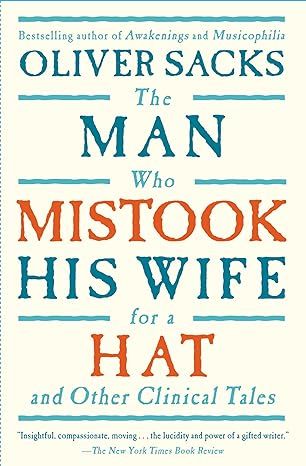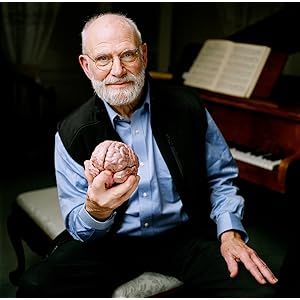The Man Who Mistook His Wife For A Hat: And Other Clinical Tales
4.4
-
7,681 ratings
In his most extraordinary book, “one of the great clinical writers of the twentieth century” (The New York Times) recounts the case histories of patients lost in the bizarre, apparently inescapable world of neurological disorders.
Oliver Sacks’s The Man Who Mistook His Wife for a Hat tells the stories of individuals afflicted with fantastic perceptual and intellectual aberrations: patients who have lost their memories and with them the greater part of their pasts; who are no longer able to recognize people and common objects; who are stricken with violent tics and grimaces or who shout involuntary obscenities; whose limbs have become alien; who have been dismissed as retarded yet are gifted with uncanny artistic or mathematical talents.
If inconceivably strange, these brilliant tales remain, in Dr. Sacks’s splendid and sympathetic telling, deeply human. They are studies of life struggling against incredible adversity, and they enable us to enter the world of the neurologically impaired, to imagine with our hearts what it must be to live and feel as they do. A great healer, Sacks never loses sight of medicine’s ultimate responsibility: “the suffering, afflicted, fighting human subject.”
Kindle
$12.99
Available instantly
Audiobook
$0.00
with membership trial
Hardcover
$23.19
Paperback
$9.00
Ships from
Amazon.com
Payment
Secure transaction
ISBN-10
0684853949
ISBN-13
978-0684853949
Print length
256 pages
Language
English
Publisher
Touchstone
Publication date
April 01, 1998
Dimensions
5.5 x 0.6 x 8.44 inches
Item weight
8 ounces
Popular Highlights in this book
Dr. P. may therefore serve as a warning and parable—of what happens to a science which eschews the judgmental, the particular, the personal, and becomes entirely abstract and computational.
Highlighted by 176 Kindle readers
For not only did Dr. P. increasingly fail to see faces, but he saw faces when there were no faces to see:
Highlighted by 123 Kindle readers
Product details
ASIN :
B091MDF73Z
File size :
10481 KB
Text-to-speech :
Enabled
Screen reader :
Supported
Enhanced typesetting :
Enabled
X-Ray :
Enabled
Word wise :
Enabled
Editorial Reviews
Clarence E. Olsen St. Louis Post-Dispatch A provocative introduction to the marvels of the human mind...
Noel Perrin Chicago Sun-Times Dr. Sacks's best book.... One sees a wise, compassionate and very literate mind at work in these 20 stories, nearly all remarkable, and many the kind that restore one's faith in humanity.
New York Magazine Dr. Sacks's most absorbing book.... His tales are so compelling that many of them serve as eerie metaphors not only for the condition of modern medicine but of modern man.
About the authors
Oliver Sacks
Oliver Sacks was born in 1933 in London and was educated at Queen's College, Oxford. He completed his medical training at San Francisco's Mount Zion Hospital and at UCLA before moving to New York, where he soon encountered the patients whom he would write about in his book Awakenings.
Dr Sacks spent almost fifty years working as a neurologist and wrote many books, including The Man Who Mistook His Wife for a Hat, Musicophilia, and Hallucinations, about the strange neurological predicaments and conditions of his patients. The New York Times referred to him as 'the poet laureate of medicine', and over the years he received many awards, including honours from the Guggenheim Foundation, the National Science Foundation, the American Academy of Arts and Letters, and the Royal College of Physicians. In 2008, he was appointed Commander of the British Empire. His memoir, On the Move, was published shortly before his death in August 2015.
Read more
Reviews
Customer reviews
4.4 out of 5
7,681 global ratings
Miguel
5
beautiful music, when in actuality they were suffering from ...
Reviewed in the United States on May 2, 2018
Verified Purchase
Oliver Sacks’ The Man Who Mistook His Wife for a Hat is a collection of recounted case histories of patients suffering from a wide variety of neurological disorders. The book is separated into 4 sections: “Losses,” “Excesses,” “Transports,” and “The World of the Simple.” Each section contains a series of case studies having to do with a specific aspect of neurology, which is defined as “the field of science dealing with the nervous system.” The author, Oliver Sacks, is a British Neurologist who earned his medical degree at Oxford University (Queen’s College) and has lived in New York since 1965 as a practicing neurologist. Currently he is a neurology professor at the NYU School of Medicine, continuing his practice in the NYU Comprehensive Epilepsy Center. Throughout the different sections of the novel, Sacks pairs these short-story-like case histories with “normal” language to provide readers with a more comprehensible understanding of the complex workings of varying neurological disorders. Through his poetic storytelling and thorough understanding of neurological disorders and the brain, Sacks brings attention to the ways in which these disorders content that can be accessible to the reader which makes him even more credible. In part one of the book titled “Losses,” Sacks discusses neurological disorders that are considered to be “deficits” in normal neurological functioning. He makes the claim that neurologists have the tendency to label nearly all neurological disorders as deficits. This basically means that the individual has some sort of impairment in performance ranging from loss of vision to loss of memory. Based on what we learned in class about the anatomy of the brain, we know that the areas of the brain specifically being affected in these cases are the occipital lobe and hippocampus. Sacks also brings up how this model of mental illness being a deficit is not entirely accurate because such little research has been done on the right hemisphere of the brain in comparison to the left hemisphere. Another point made is that the affected subjects aren’t given enough credit for their abilities to find ways to compensate for whatever “deficit” they are suffering from. He brings light to such abilities in the case studies provided in this section. In part two of the book titled “Excesses,” Sacks discusses the overabundance of neurological functioning, the contrary to deficits in metal processes. Rather than focusing strictly on the ways this “excess” affects the brain, Sacks displays how an overabundance of function impacts patients’ daily lives. These case studies primarily consist of patients suffering from Tourette’s Syndrome, which as we know from class is due to there being complications with the basal ganglia (controls body movement), as well as there being less white matter in the brains of individuals with this disorder. In part three of the book, titled “Transports,” Sacks discusses cases in which neurological conditions altered patients’ perceptions of reality, in ways that can be deemed imaginative, euphoric, and even “otherworldly.” As it is brought up in the case studies within the section, majority of the cases have to do with seizures disturbing certain regions of the brain. One example given of this was how these women claimed to be hearing loud, beautiful music, when in actuality they were suffering from recurring seizures in the temporal lobe of their brains, which we know to be in control of one’s auditory perception. Lastly, in the final portion of the book titled “The World of the Simple,” Sacks discusses the work he has done with individuals who are mentally challenged in some way. A major theme brought up in the case studies he provides for this section is “concreteness,” which is, in the case of those who are mentally challenged, the way they perceive the world as a collection of material things rather than abstract concepts. He brings light to the true beauty behind such individuals which may seem depressing to one at face value. With this, he ends his book with the stories of individuals who may not perceive the world and its complexities, but how despite this ability to do so, these mentally challenged patients of his have a strong connection with the concrete world in their musical or mathematical gifts, for example, while still having mental deficiencies, showing that they too are simply human. When it comes to the ways in which Sacks creates a book that is accessible and much more credible than others he does this by adding outside sources and making the stories he tells both poetic and understandable. He doesn’t try to make it so that neurological disorders are inaccessible to a wider audience. This book reads in a way that anyone, interested in neuroscience or not, can understand it and want to continue to learn about it. In Chapter 18, “The Dog Beneath the Sun”, Sacks brings up the story of a medical student, age 22, on highs. The way this chapter reads is so that it can be accessed by all, the fact that right off the bat this is a profile on someone that any college student can relate too, especially, makes it even more accessible. Sacks states in one of his footnotes clarifying “a strange nostalgia…” (156) that it is a “a strange emotionalism…reminiscence”. The fact that this footnote creates a sense of understanding beyond what is just written shows that Sacks puts in care to wanting his audience to more deeply understand the subject matter. As the case study continues we learn about the enhancement of smell being affiliated with “paraphilia, fetishism, and allied perversions and regressions.” (158) The reason this part is another solid example of Sacks credibility is because in his footnotes he thing refers to this later being described by A.A Brill in 1932 as a “contrast with the overall brilliance, the redolence, of the smell world…” (158). The truth of the matter is that through the creation of access, which is what Sacks is doing by using such simple terms, neuroscience is becoming accessible and something that anyone can enjoy which, in a way, even furthers his credibility. Knowledge like this should be accessible to all not just those who can afford and education and to study it and Sacks is doing just that. All in all, The Man Who Mistook His Wife for a Hat is Oliver Sacks’ way of creating access for all into the realm of neuroscience. The way this book is broken up into four parts makes it easier to digest and creates for a sense of fluidity that makes the reader continue to wonder about other neurological findings. Lastly, looking back at the ways in which Sacks creates accessibility his clear use of simple yet poetic language makes it so that there is a further want to continue to understand neuroscience as a whole instead of just running away from it. The fact that this is written to be understood makes it so that it is much more enjoyable and more easily digested which is, in many ways, a way of inviting all to enjoy the world of neuroscience not just those who have exclusive access to it.
Read more
27 people found this helpful
Kindle Customer
5
Wow, just wow.
Reviewed in the United States on April 26, 2024
Verified Purchase
He is amazing — watch his TED talks. One of the most brilliant minds in a century. This book was the first I read and it lead me on a lifetime of curiosity about the mind. I always give this book and Tales of a Female Nomad to people who I feel will appreciate expending their minds and hearts.
Brent Portz
5
Book for General Readers and Students of Neuroscience alike!
Reviewed in the United States on September 28, 2009
Verified Purchase
Seldom is a book intended for a narrow discipline and capable of reaching general audiences with limited field knowledge. Clinical neurologist, Oliver Sacks, however, skillfully authors The Man who Mistook his Wife for a Hat for students of neuroscience without repressing less familiar audiences. The power of the brain is witnessed here through examination of clinical cases where normal function of the brain is lost and neurological disorders result.
Provocative accounts from Sacks's actual patients mark his book and illustrate the dissocializing nature of neurological disorders. "Dr. G" of Chapter 1 exemplifies this notion as his visual memory is lost after sustaining brain damage. As a result, Dr. G errantly recognizes objects, i.e. his wife for a hat, as titled. Social implications are associated with his disorder and are observed at home as well as at work. Additional case histories are discussed subsequently, all converging to support a common effect of neurological disorders: social unrest and continuous dependence on others. Twenty-two patient histories are examined in total. Sacks classifies patient disorders into two broad-ranging categories that conveniently serve as a division in the book: losses and excesses. Losses are explained to "denote an impairment or incapacity of neurological function" (p. 3). Alternatively, "excesses" are also hallmarks of neurological disorders, however, less common and characterized through a "superabundance of function," seemingly the opposite function of losses (p. 88).
Sacks begins his description of aberrant neurology through examining patients with loss of function. Justification can be derived for this decision with the observation that abnormalities display characteristics otherwise concealed by normal function. As described above, "Dr. G" portrayed in Chapter 1 begins to illustrate the consequences of a debilitating neurological disorder. To further expand this, "Christina" (Chapter 3: The Disembodied Lady), once very active and healthy, sustained an unfortunate accident that left her completely without sensation of her body. This left her trapped in the hospital and separated from her children and loved ones. Normal work was no longer possible and once able to return to the public scene, completing common tasks were a continuous struggle.
When further studying neurological disorders, Sacks reasons that in addition to examining loss of function, abnormal gain of function is equally possible to result in neurological disorders. In fact, Sacks intuitively recognizes that disorders "may not be apparent when we consider only loss" (p. 87). However, he additionally recognizes that (at the time of publishment - 1970) "neurology never considers such disorders of excess", therefore, such studies would be unprecedented (p. 88). Regardless, Sacks unyieldingly attempts to examine cases of excess function to gain a more comprehensive understanding of how neurological disorders affect one socially. "Ray" (Chapter 10: Witty Ticcy Ray) demonstrates an example of a patient not affected from a loss of function, but rather a gain of function. Ray experienced a condition that lead him to be hyperactive in nature, twitchy, nervous, and unsettled. Sachs utilizes Ray to demonstrate that the social implications experienced by those with abnormal gains of function are equally troubling.
Arguably, Sacks's case by case examination functions more than a technique to survey neurological disease and disorder. A more profound implication for such case studies is reached by the conclusion. Sacks seemingly describes patient case studies to demonstrate daily challenges encountered by his patients. Such challenges are apparent by observation, but their significance is otherwise unrecognized and unappreciated by the outside world. For example, the students of "Dr. G" are perplexed at his inability to distinguish among themselves in class and are unsure of how to address him. Similarly, "the lack of social support and sympathy is an additional trial" for Christina to overcome before being accepted once again into society (p. 51). Demonstrating these unique challenges enlightens the reader as how to begin to interact and respond to individuals with debilitating neurological disorders. Thus, Sacks's focus benefits individuals at two levels; those with the disorder and the interacting population. In this regard, the book distinguishes itself from similar accounts by its inherent humanistic nature.
Sachs comprehensively examines a broad-range of neurological disorders with an ultimate goal of exposing the reader to large range of techniques used by patients to manage their disorders. This goal is achieved while accommodating the needs of both the students of neurology and the more general audiences. Completing the book allows one to understand the significance of The Man Mistaking his Wife for a Hat.
Read more
3 people found this helpful
Emaly
4
He has written many best selling novels about neurology that eventually became movies
Reviewed in the United States on April 26, 2017
Verified Purchase
Oliver Sacks was a neurologist, author, and a professor. He grew up and studied in London, England. Dr. Sacks moved to the United States to complete his residency program in neurology and stayed in the U.S. to work (Oliver Sacks, M.D. 2017). He has written many best selling novels about neurology that eventually became movies. The book that I read, “The Man Who Mistook His Wife for a Hat and Other Clinical Tales” is a collection of short stories based upon case histories that Dr. Sacks personally experienced with his patients. The main idea of this book is to explain to readers about certain neurological and neuropsychiatric disorders. At first I thought this book would be difficult to read as it focuses on complex medical diseases and conditions of the brain. I envisioned his book being filled with complicated medical terminology that would be difficult to understand. To my surprise, Dr. Sacks wrote the book in an engaging way for general readers to comprehend. He explains his patient’s multifaceted neurological disorders in a simple, emotional, and understandable language. I enjoyed the book and it was easy to navigate through each of the individual stories. It consisted of 24 separate short stories that were categorized into four different sections. Each section had a specific theme. The four themes of the book were losses, excesses, transports, and The World of the Simple. In the section about losses, Dr. Sacks explains nine different case histories of patients who have lost a specific neurological function of their brain. One person lost the ability to remember anything after 1945. This patient thought he was nineteen when in reality he was much older. Another patient has no proprioception and has lost the ability to feel her body. In the second section about excesses, Dr. Sacks explains five different case studies about people who have an excessive amount of emotions or energy. For example, Dr. Sacks explains the story of a man with Tourette’s syndrome. Tourette’s syndrome causes repetitive movement and a Tic Disorder. However, this patient had quick reactions. Another story was about a ninety year old women with syphilis who now feels more energetic. In many cases Dr. Sacks tries to treat his patients with medication to slow them down, however after he gave them the medication he felt the patient’s would be better off without it. The third section on transports is about patients, who have hallucinations, spiritual journeys, visions, or dreams that transport them to a different state. These patients have undergone psychological and physical changes. There was one story about a medical student who thought he was a dog. The patient actually sniffed like a dog. Another story is about a girl with a brain tumor who thought she was back in her country of India. Part four was the last section of the book and it was about the world of the simple. These patients have thoughts that were simple and innocent to remember but they didn’t understand their thoughts. One story was about a 21 year old young man named Jose who had autism. Jose does not talk but he was a remarkable artist. People criticized Jose and called him an idiot, but Jose could draw an object or scene with great focus and detail. I found Dr. Sack’s stories very interesting particularly because they were related to true case histories. His own personal experience and interactions with his patients offers creditability for the knowledge he shares with us. Dr. Sack’s descriptive explanations of the case histories helped put complex neurological diseases in perspective. He used simple terminology and easy to understand examples. Many of his stories were relatable to the topics we discussed in class such as the functionality of the brain. One of most interesting stories Dr. Sacks discusses was related to the title of the book “The Man Who Mistook his Wife for a Hat”. Dr. Sacks was treating a patient who had a massive tumor that was damaging his visual cortex and other visual parts of his brain. This patient could not process sensory information and therefore had difficulty differentiating reality from fantasy. Physically the patient felt fine and did not even realize he had a problem. However in reality he was encountering progressive cognitive failure to identify faces. The term for this neurological disease is prosopagnosia. People who are diagnosed with prosopagnosia struggle recognizing people faces and sometimes cannot even recognize their own face. Dr. Sack’s patient was also affected by another neurological disease called agnosia. Agnosia is the inability to recognize places and things. In this case Dr. Sack’s patient literally mistook his wife for a hat and attempted to grab her head and place it on his. His patient’s only sensory function, the sense of smell assisted him in identifying simple objects. In each story Dr. Sack’s explained his patient’s symptom and gives a background of the patient’s life. He further explains what neurological conditions the patient had and why they had this condition. Dr. Sack’s used neurological examples that were explained in a simple way and were easy and interesting to understand. Dr. Sack’s arguments that described his patient’s disorders were well-constructed and well explained using neurological evidence to validate his statements.
Read more
7 people found this helpful
Bambi Barich
3
but that is due to my disappointment in how lackluster the neuroscience content is
Reviewed in the United States on April 25, 2017
Verified Purchase
Oliver Sacks was an established neurologist who earned his neuroscience degree from the Queen’s College, which is a part of the larger Oxford College in Oxford, England. This degree in neuroscience is essentially what caused him to become a famous author in addition to being a neurologist, as the majority of his literary works revolve around the subjects of neuroscience and the brain. Personally, I was excited to read his book The Man Who Mistook His Wife for a Hat, as I find neuroscience to be quite fascinating. However, upon finishing the book, I fear that Dr. Sacks has let his popularity as an author from his previous works, Awakenings and Musicophilia, distract him from educating the general populous about neuroscience and has instead gravitated towards more sensational writings which are themed around neuroscience, as evidenced by The Man Who Mistook His Wife for a Hat. Admittedly, my general viewpoint on The Man Who Mistook His Wife for a Hat is harsh, but that is due to my disappointment in how lackluster the neuroscience content is. However, my hindsight tells me that I too was drawn to the book for its curious title and therefore should not be complaining as much as I am because I may not have been his target audience. The book, The Man Who Mistook His Wife for a Hat, chronicles the experiences and patients that Dr. Sacks encountered throughout his career as a neurologist. It seems that the purpose of this book was to highlight and explore the more puzzling and bizarre neurological anomalies in a way that is both engaging and educative to both the casual reader and to the person who is more well-versed in neuroscience. The book achieves this through separating itself into four sections: losses, excesses, transports, and the world of the simple. Each of the four sections relates to a specific type of functioning in the brain, an example of this would be how the section titled losses pertains to a client’s loss or dampening of normal cognitive or physical functioning as noted by Dr. Sacks. With the book being divided into four sections, it allows the reader to either read the book linearly, as a normal book is intended, or the simply pick a section that interests them and start there. Personally, I felt that the book was too simplistic, which is also probably why it was to popular. I say this because, if you were to flip to a random page in the book, you would most likely be able to comprehend everything on the page. I would even go as far to say that the average person probably would not feel challenged intellectually while they were reading it. However, from a business perspective, this is readability is undoubtedly a strength because if more people are able to comprehend the book and feel comfortable reading it, the more potential sales. However, upon finishing the book, it seemed all too clear that the book’s main purpose was only to sell multiple copies, much like a book you might find at an airport and not to broaden one’s understanding of neurological concepts. As I had mentioned earlier, I was a tad disappointed that there was not much neuroscience content, especially when the author is such an acclaimed neuroscientist, which also seems to support my theory that the main purpose of the book was primarily for the sales as opposed to highlighting some of the fascinating neurological disorders. However, before I start addressing how there was a severe lack of stimulating neurological content, I will address that there are a few neuroscience terms sprinkled throughout the book such as temporal lobe, amygdala, and L-Dopa. Both the temporal lobe and the amygdala are some of the most memorable parts of the brain, whereas L-Dopa is a lesser known amino acid. Initially, I was excited when I saw that L-Dopa was included in the book because I am very interested in how amino acids, neurotransmitters, and hormones effect the brain but unfortunately, L-Dopa is the most advanced subject of the book and is also rarely touched upon in the book. Also, the majority of the neuroscience content is only in the prefaces and the post scripts, both of which make up the smallest portions of the book. In continuation with my criticisms of the book, I felt that Dr. Sacks also seems to be constantly rephrasing what he has stated earlier in each of his journals. Most of this seemed subtle, such as bringing up topics that were previously addressed in the chapter or changing his wording around slightly but other instances made me feel like I was constantly re-reading something that I had just read a few paragraphs earlier. I found this issue of rephrasing to be most prevalent in “The Lost Mariner” where Dr. Sacks keeps rewording the term memory loss. I do understand that from a story telling perspective that it is important to illuminate key themes, but in the case of “The Lost Mariner”, it almost seems ironic that Dr. Sacks, much like his patient, keeps repeating things that he has established in the past. While I didn’t feel that the book was a great fit for me, if the reader is someone who is beginning to develop a curiosity about neuroscience, then this book is a fantastic tool to help satiate that curiosity. The Man Who Mistook His Wife for a Hat does a great job of framing the world of neuroscience in a fun and engaging way through Dr. Sack’s recollections of previous patient interactions. These interactions are worded in such a way that any reader can understand what the patient is suffering from and how the brain is involved with the strange behavior or disabilities that is occurring in the patient. In addition, if the reader was still hungry for more information about the previous cases, Dr. Sack’s also does a great job at illuminating what he thinks may have been occurring in some of the post-scripts and he even goes as far to provide current research done on the topic or updates the reader on the new developments in the client’s cases. To conclude, while I found this book to be a bit of a disappointment, I believe this was due to me not being Dr. Sack’s intended audience for The Man Who Mistook His Wife for a Hat. My reasoning behind this is that I believe it was Dr. Sack’s intention for this book to be targeted towards people who have a budding interest in neuroscience and not someone who has or is beginning to develop a background in neuroscience. If you are a part of that audience, then I firmly believe that this book will help to lead the reader down an exciting and engaging trail of bizarre, and at times heartbreaking, client interactions all of which are easy and fun to read. However, if you are like myself and crave something more stimulating, then I feel that the book is not a great fit for you and that you are better suited pursuing something more challenging.
Read more
3 people found this helpful
Similar Books
Best Sellers

The Great Alone: A Novel
4.6
-
152,447
$5.49

The Four Winds
4.6
-
156,242
$9.99

Winter Garden
4.6
-
72,838
$7.37

The Nightingale: A Novel
4.7
-
309,637
$8.61

Steve Jobs
4.7
-
24,596
$1.78

Iron Flame (The Empyrean, 2)
4.6
-
164,732
$14.99

A Court of Thorns and Roses Paperback Box Set (5 books) (A Court of Thorns and Roses, 9)
4.8
-
26,559
$37.99

Pretty Girls: A Novel
4.3
-
88,539
$3.67

The Bad Weather Friend
4.1
-
34,750
$12.78

Pucking Around: A Why Choose Hockey Romance (Jacksonville Rays Hockey)
4.3
-
41,599
$14.84

Start with Why: How Great Leaders Inspire Everyone to Take Action
4.6
-
37,152
$9.99

Tomorrow, and Tomorrow, and Tomorrow: A novel
4.4
-
95,875
$13.99

Weyward: A Novel
4.4
-
27,652
$11.99

Tom Lake: A Reese's Book Club Pick
4.3
-
37,302
$15.74

All the Sinners Bleed: A Novel
4.4
-
12,894
$13.55

The Mystery Guest: A Maid Novel (Molly the Maid)
4.3
-
9,844
$14.99

Bright Young Women: A Novel
4.2
-
8,485
$14.99

The Wager: A Tale of Shipwreck, Mutiny and Murder (Random House Large Print)
4.5
-
28,672
$14.99

Hello Beautiful (Oprah's Book Club): A Novel (Random House Large Print)
4.4
-
79,390
$14.99

Small Mercies: A Detective Mystery
4.5
-
16,923
$10.00

Holly
4.5
-
31,521
$14.99

The Covenant of Water (Oprah's Book Club)
4.6
-
69,712
$9.24

Wellness: A novel
4.1
-
3,708
$14.99

The Art Thief: A True Story of Love, Crime, and a Dangerous Obsession
4.3
-
4,805
$14.99


